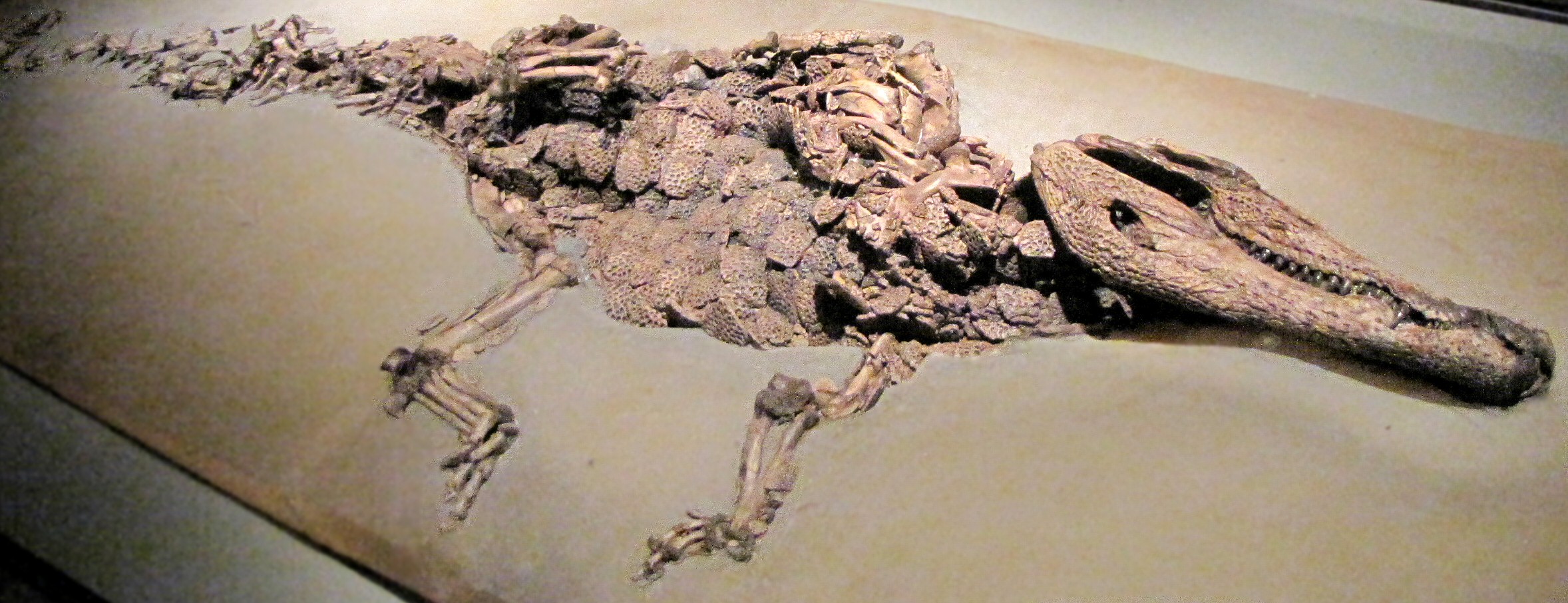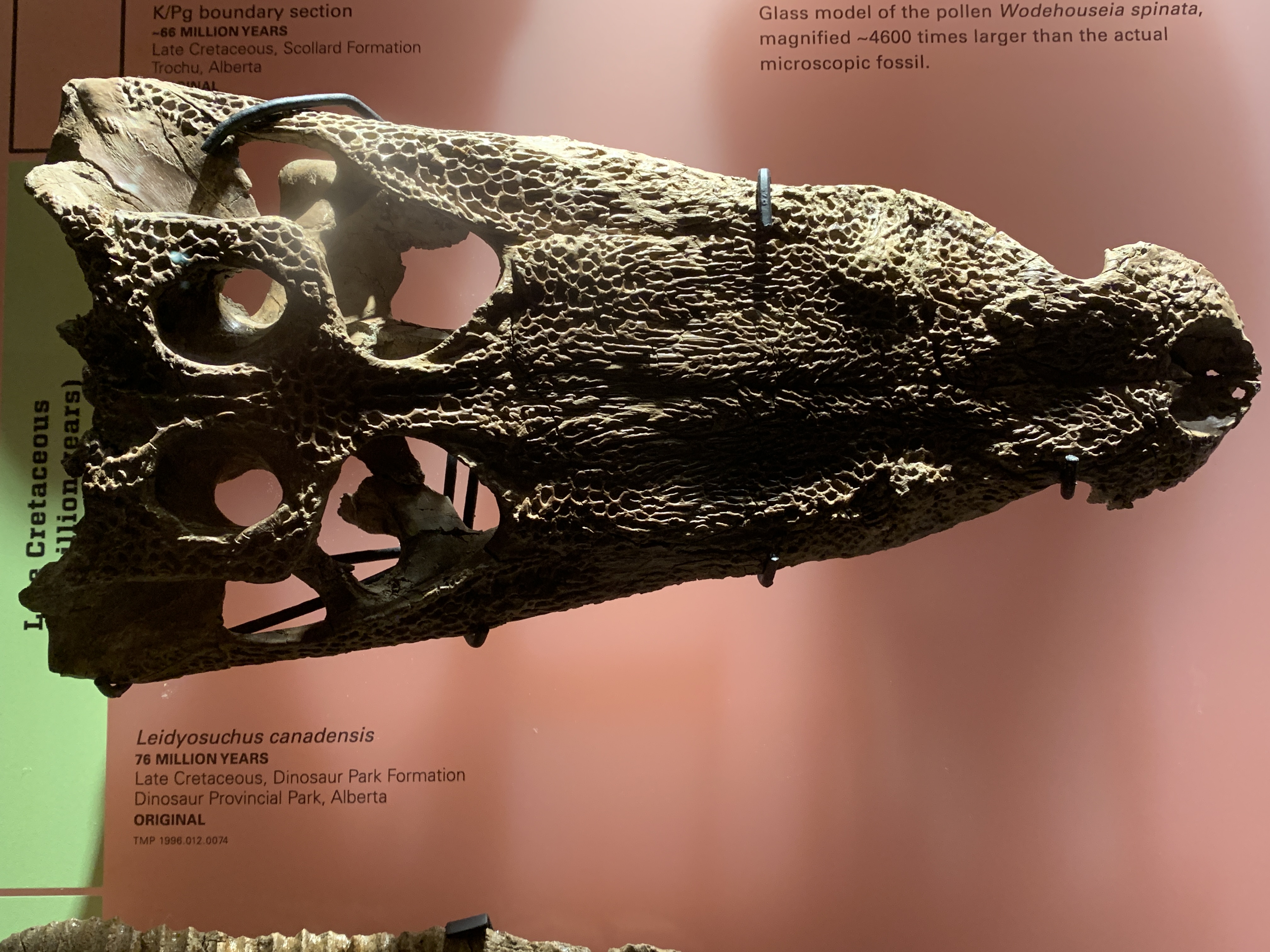|
Alligatoroidea
Alligatoroidea is one of three superfamilies of crocodylians, the other two being Crocodyloidea and Gavialoidea. Alligatoroidea evolved in the Late Cretaceous period, and consists of the alligators and caimans, as well as extinct members more closely related to the alligators than the two other groups. Evolution The superfamily Alligatoroidea is thought to have split from the crocodile-gharial lineage in the late Cretaceous, about 80 million years ago, but possibly as early as 100 million years ago based on molecular phylogenetics. '' Leidyosuchus'' of Alberta is the earliest known genus. Although, a 2025 study considers it and Deinosuchus to be non-crocodylian eusuchians closely related to crocodylians. Fossil alligatoroids have been found throughout Eurasia as land bridges across both the North Atlantic and the Bering Strait have connected North America to Eurasia during the Cretaceous, Paleogene, and Neogene periods. Alligators and caimans split in North America dur ... [...More Info...] [...Related Items...] OR: [Wikipedia] [Google] [Baidu] |
Deinosuchus
''Deinosuchus'' is an extinct genus of eusuchian, either an Alligatoroidea, alligatoroid Crocodilia, crocodilian or a stem-group crocodilian, which lived during the Late Cretaceous around . The first remains were discovered in North Carolina (United States) in the 1850s, and the genus was first described in 1909. Additional fragments were discovered in the 1940s and were later incorporated into an influential, though inaccurate, skull reconstruction at the American Museum of Natural History. Knowledge of ''Deinosuchus'' remains incomplete, but better Skull, cranial material found in recent years has expanded scientific understanding of this massive predator. Although ''Deinosuchus'' was far larger than any modern crocodile or alligator, with the largest adults measuring in total length, its overall appearance was fairly similar to its smaller relatives. It had large, robust teeth built for crushing, and its back was covered with thick hemispherical osteoderms. One study indic ... [...More Info...] [...Related Items...] OR: [Wikipedia] [Google] [Baidu] |
Diplocynodon
''Diplocynodon'' is an extinct genus of eusuchian, either an alligatoroid crocodilian or a stem-group crocodilian, that lived during the Paleocene to Middle Miocene in Europe. Some species may have reached lengths of , while others probably did not exceed . They are almost exclusively found in freshwater environments. The various species are thought to have been opportunistic aquatic predators. In the nineteenth century, ''D. steineri'' was named from Styria, Austria and ''D. styriacus'' was named from Austria and France. A third Austrian species, ''Enneodon ungeri'', was placed in its own genus. The Austrian and French species of ''Diplocynodon'' were synonymized with ''E. ungeri'' in 2011, and because the name ''Diplocynodon'' has priority over ''Enneodon'', the species is now called ''D. ungeri''. Other genera have recently been found to be synonymous with ''Diplocynodon''. ''Hispanochampsa muelleri'' of Spain was determined to be synonymous with ''Diplocynodon'' in 2006, and ... [...More Info...] [...Related Items...] OR: [Wikipedia] [Google] [Baidu] |
Leidyosuchus
''Leidyosuchus'' (meaning " Leidy's crocodile") is an extinct genus of eusuchian, either an alligatoroid crocodilian or a stem-group crocodilian, from the Late Cretaceous of Alberta. It was named in 1907 by Lawrence Lambe, and the type species is ''L. canadensis''. It is known from a number of specimens from the middle Campanian age Dinosaur Park Formation. It was a medium-sized alligatoroid, with a maximum skull length greater than 40 centimeters (16 in). A number of species had been assigned to this genus over the years, including: ''L. acutidentatus'' ( Sternberg, 1932), from the Paleocene of Saskatchewan; ''L. formidabilis'' ( Erickson, 1976), from the Paleocene of North Dakota and Wyoming; ''L. gilmorei'' (Mook, 1942), from the Campanian of Alberta; ''L. multidentatus'' (Mook, 1930); ''L. riggsi'' (Schmidt, 1938); ''L. sternbergii'' ( Gilmore, 1910), from the Maastrichtian (Late Cretaceous) of Colorado, Montana, North Dakota, South Dakota, and Wyoming; and ''L. ... [...More Info...] [...Related Items...] OR: [Wikipedia] [Google] [Baidu] |
Globidonta
Globidonta is a clade of alligatoroids that includes alligators, caimans, and closely related extinct forms. It is defined as a Stem-based taxon, stem-based clade including ''Alligator mississippiensis'' (the American Alligator) and all forms more closely related to it than to ''Diplocynodon''. The group's fossil range extends back into the Campanian stage of the Late Cretaceous with early alligatoroids such as ''Albertochampsa'' and ''Brachychampsa''. Extinct globidontans were particularly common in North America and Eurasia, and their modern range also includes South America. Basal globidontans are characterized by their blunt snouts and bulbous teeth. Modern globidontans have flattened snouts and more conical teeth, and are seen as more generalized than earlier globidontans. Generalized forms are usually expected to be ancestral to more specialized forms rather than descendants of them, so it is unusual for basal members of the group to appear specialized. This seems to conflic ... [...More Info...] [...Related Items...] OR: [Wikipedia] [Google] [Baidu] |
Crocodyloidea
Crocodyloidea is one of three superfamilies of crocodilians, the other two being Alligatoroidea and Gavialoidea, and it includes the crocodiles. Crocodyloidea may also include the extinct Mekosuchinae, native to Australasia from the Eocene to the Holocene, although this is disputed. Classification Cladistically, it is defined as ''Crocodylus niloticus'' (the Nile crocodile) and all crocodylians more closely related to ''C. niloticus'' than to either ''Alligator mississippiensis'' (the American alligator) or ''Gavialis gangeticus'' (the gharial). This is a stem-based definition for crocodiles, and is more inclusive than the crown group Crocodylidae. As a crown group, Crocodylidae only includes the last common ancestor of all extant (living) crocodiles and their descendants (living or extinct), whereas Crocodyloidea, as a stem group, also includes more basal extinct crocodile ancestors that are more closely related to living crocodiles than to alligators or gavialids. Whe ... [...More Info...] [...Related Items...] OR: [Wikipedia] [Google] [Baidu] |
Gavialoidea
Gavialoidea is one of three superfamily (zoology), superfamilies of crocodylians, the other two being Alligatoroidea and Crocodyloidea. Although many extinct species are known, only the gharial ''Gavialis gangeticus'' and the false gharial ''Tomistoma schlegelii'' are alive today, with ''Hanyusuchus'' having become extinct in the last few centuries. Extinct South American gavialoids likely Dispersal (ecology), dispersed in the mid Tertiary period, Tertiary from Africa and Asia. Fossil remains of the Puerto Rican gavialoid ''Aktiogavialis puertorisensis'' were discovered in a cave located in San Sebastián, Puerto Rico and dated to the Oligocene. This individual is thought to have crossed the Atlantic coming from Africa, indicating that this species was able to withstand saltwater. Classification Gavialoidea is Cladistics, cladistically defined as ''Gavialis gangeticus'' (the gharial) and all crocodylians closer to it than to ''Alligator mississippiensis'' (the American alligator) ... [...More Info...] [...Related Items...] OR: [Wikipedia] [Google] [Baidu] |
Eusuchia
Eusuchia is a clade of neosuchian Crocodylomorpha, crocodylomorphs that first appeared in the Early Cretaceous, which includes modern Crocodilia, crocodilians. Along with Dyrosauridae and Sebecosuchia, they were the only crocodyliformes who survived the Cretaceous–Paleogene extinction event, K-Pg extinction. Definition Eusuchia was originally defined by Thomas Henry Huxley in 1875 as an apomorphy-based group, meaning that it was defined by shared characteristics rather than relations. These characteristics include pterygoid-bounded choanae and vertebrae which are procoelous (concave from the front and convex from the back). The possibility that these traits may have been Convergent evolution, convergently evolved in different groups of neosuchians rather than one lineage spurred some modern paleontologists to revise the group's definition to make it defined solely by relations. In 1999, Christopher Brochu redefined Eusuchia as "the last common ancestor of ''Hylaeochampsa'' and C ... [...More Info...] [...Related Items...] OR: [Wikipedia] [Google] [Baidu] |
Listrognathosuchus
''Listrognathosuchus'' is an extinct genus of alligatoroid crocodilian. Fossils date back to the middle Paleocene epoch. In 1997, the generic name replaced that of ''Leidyosuchus'' for the species ''L. multidentatus'' (now the type species of ''Listrognathosuchus''). ''"L." multidentalis'' was first described by Charles Mook in 1930 on the basis of the holotype AMNH 5179, consisting of a partial vertebral column, mandible, partial left ilium, and left tibia, found from a locality in Torrejon Arroyo, New Mexico (then referred to as the Torrejon beds, and now thought to be part of the Nacimiento Formation). Phylogenetics The fragmentary nature of the material referable to ''Listrognathosuchus'' have made it hard to classify within Crocodylia, but it is now thought to be a relatively basal alligatoroid. ''Listrognathosuchus'' is closely related to ''Borealosuchus ''Borealosuchus'' (meaning "northern crocodile") is an extinct genus of crocodyliforms that lived from the Late Cret ... [...More Info...] [...Related Items...] OR: [Wikipedia] [Google] [Baidu] |
Crocodilia
Crocodilia () is an order of semiaquatic, predatory reptiles that are known as crocodilians. They first appeared during the Late Cretaceous and are the closest living relatives of birds. Crocodilians are a type of crocodylomorph pseudosuchian, a subset of archosaurs that appeared about 235 million years ago and were the only survivors of the Triassic–Jurassic extinction event. While other crocodylomorph groups further survived the Cretaceous–Paleogene extinction event, notably sebecosuchians, only the crocodilians have survived into the Quaternary. The order includes the true crocodiles (family Crocodylidae), the alligators and caimans (family Alligatoridae), and the gharial and false gharial (family Gavialidae). Although the term "crocodiles" is sometimes used to refer to all of these families, the term "crocodilians" is less ambiguous. Extant crocodilians have flat heads with long snouts and tails that are compressed on the sides, with their eyes, ears, and n ... [...More Info...] [...Related Items...] OR: [Wikipedia] [Google] [Baidu] |
Alligators
An alligator, or colloquially gator, is a large reptile in the genus ''Alligator'' of the family Alligatoridae in the order Crocodilia. The two extant species are the American alligator (''A. mississippiensis'') and the Chinese alligator (''A. sinensis''). Additionally, several extinct species of alligator are known from fossil remains. Alligators first appeared during the late Eocene epoch about 37 million years ago. The term "alligator" is likely an anglicized form of ', Spanish for "the lizard", which early Spanish explorers and settlers in Florida called the alligator. Early English spellings of the name included ''allagarta'' and ''alagarto''. Evolution Alligators and caimans split in North America during the early Tertiary or late Cretaceous (about 53 million to 65 million years ago). The Chinese alligator split from the American alligator about 33 million years ago and probably descended from a lineage that crossed the Bering land bridge during ... [...More Info...] [...Related Items...] OR: [Wikipedia] [Google] [Baidu] |
Alligator
An alligator, or colloquially gator, is a large reptile in the genus ''Alligator'' of the Family (biology), family Alligatoridae in the Order (biology), order Crocodilia. The two Extant taxon, extant species are the American alligator (''A. mississippiensis'') and the Chinese alligator (''A. sinensis''). Additionally, several extinct species of alligator are known from fossil remains. Alligators first appeared during the late Eocene epoch about 37 million years ago. The term "alligator" is likely an Anglicisation (linguistics), anglicized form of ', Spanish language, Spanish for "the lizard", which early Spanish explorers and settlers in Florida called the alligator. Early English language, English spellings of the name included ''allagarta'' and ''alagarto''. Evolution Alligators and caimans split in North America during the early Tertiary period, Tertiary or late Cretaceous (about 53 million to 65 million years ago). The Chinese alligator split from the America ... [...More Info...] [...Related Items...] OR: [Wikipedia] [Google] [Baidu] |
Alligator Prenasalis
''Alligator prenasalis'' is an extinct species of alligator from the Late Eocene period. It is well known, with many fossils having been collected from the Chadron Formation, Chadron and Brule Formations in South Dakota. The species was first named in 1904, but was originally classified as a crocodile in the genus ''Crocodilus''. It was reassigned to the genus ''Alligator'' in 1918 on the basis of more complete material. It is the earliest known member of the genus ''Alligator''. Taxonomy Junior synonyms Several species of extinct Alligatorinae, alligatorines have been considered junior synonyms of ''A. prenasalis''. These include ''Caimanoidea visheri'', named by paleontologist Maurice Mehl in 1916 from fragmentary material, and ''Allognathosuchus riggsi'', named in 1931 from a single piece of a lower jaw. Both were considered synonymous with the species in 1972 by paleontologist D.W. Higgins. Mehl used two alternate spellings of ''Caimanoidea'' in his 1916 paper: ''Caimanoideu ... [...More Info...] [...Related Items...] OR: [Wikipedia] [Google] [Baidu] |








